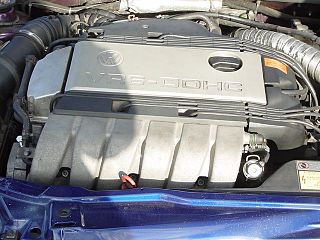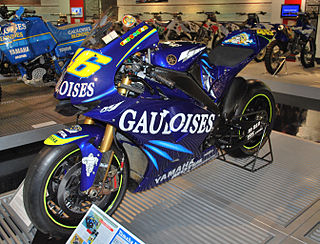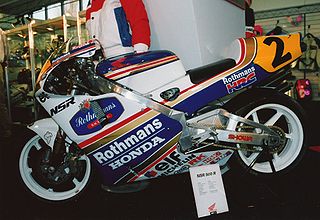Related Research Articles

A V6 engine is a six-cylinder piston engine where the cylinders share a common crankshaft and are arranged in a V configuration.
The engine configuration describes the fundamental operating principles by which internal combustion engines are categorized.

A straight-four engine is a four-cylinder piston engine where cylinders are arranged in a line along a common crankshaft.

The inline-six engine is a piston engine with six cylinders arranged in a straight line along the crankshaft. A straight-six engine has perfect primary and secondary engine balance, resulting in fewer vibrations than other designs of six or fewer cylinders.
The straight-five engine is a piston engine with five cylinders mounted in a straight line along the crankshaft.

In a piston engine, the cylinder head sits above the cylinders, forming the roof of the combustion chamber. In sidevalve engines the head is a simple plate of metal containing the spark plugs and possibly heat dissaption fins. In more modern overhead valve and overhead camshaft engines, the head is a more complicated metal block that also contains the inlet and exhaust passages, and often coolant passages, Valvetrain components, and fuel injectors.

A straight-three engine is a three-cylinder piston engine where cylinders are arranged in a line along a common crankshaft.

A W engine is a type of piston engine where three or four cylinder banks use the same crankshaft, resembling the letter W when viewed from the front.

The Volkswagen Corrado is a compact four passenger (2+2), three door, front-engine, front-wheel-drive liftback coupe marketed by Volkswagen from 1988 until 1995, and manufactured by Karmann in Osnabrück, Germany.
The Honda XR series is a range of four-stroke off-road motorcycles that were designed in Japan but assembled all over the world.

The VR6 engine is a six-cylinder engine configuration developed by VW. The name VR6 comes from the combination of German words “Verkürzt” and “Reihenmotor” meaning “shortened inline engine”. It was developed specifically for transverse engine installations and FWD vehicles. The VR6 is a highly compact engine, thanks to the narrower angle of 10.5 to 15 degrees between cylinder banks, as opposed to the traditional V6 angles ranging from 45 to 90 degrees. The compact design is cheaper to manufacture, since only one cylinder head is required for all six cylinders, much like a traditional inline-6 engine.

A U engine is a piston engine made up of two separate straight engines placed side-by-side and coupled to a shared output shaft. When viewed from the front, the engine block resembles the letter "U".

A multi-valve or multivalve engine is one where each cylinder has more than two valves. A multi-valve engine has better breathing, and with more smaller valves may be able to operate at higher revolutions per minute (RPM) than a two-valve engine, delivering more power.

The Honda RC211V is a 990 cc four-stroke race motorcycle from HRC developed in 2001 to replace the two-stroke Honda NSR500.

Italian automobile company Lancia was the first to manufacture cars with V4 and V6 engines in series-production. This started with a number of V4-engine families, that were produced from the 1920s through 1970s.

A motorcycle engine is an engine that powers a motorcycle. Motorcycle engines are typically two-stroke or four-stroke internal combustion engines, but other engine types, such as Wankels and electric motors, have been used.

The Honda NR was a V-four motorcycle series started by Honda in 1979 with the 500cc NR500 Grand Prix racer that used oval pistons. This was followed during the 1980s by a 750cc endurance racer version known as the NR750. The oval piston concept allowed for eight valves per cylinder which generated more power due to the increased air/fuel mixture and throughout compression. In 1992 Honda produced around 300 street versions of a 750cc model, the NR, with a 90-degree V angle. Whereas the NR500 had used an oval piston with straight sides, the road going NR750 used an elliptical piston with curved long sides. The bike became the most expensive production bike at the time when it was selling for $50,000 and with the rarity, nowadays they rarely change hands.

The Yamaha YZR-M1 is an inline-four motorcycle specifically developed by Yamaha Motor Company to race in the current MotoGP series. It succeeded the 500 cc (31 cu in) YZR500 by the 2002 season and was originally developed with a 990 cc (60 cu in) engine. Since then, the YZR-M1 has been continuously developed into several iterations through the 990cc, 800cc and 1000cc eras of Grand Prix Motorcycle Racing.

The Honda NSR500 is a road racing motorcycle created by HRC and debuted in 1984 for the Grand Prix motorcycle racing's 500 cc class. Honda won ten 500cc World Championships with the NSR500 from 1984 to 2002, with six in a row from 1994 to 1999. With more than 100 wins to its credit, the NSR500 is the most dominant force in modern Grand Prix motorcycle racing. The 1989 NSR500 that won Honda's third 500 World Championship with Eddie Lawson exemplifies the overwhelming power, acceleration and raw speed that has always been synonymous with Honda's 500 cc two-stroke V4.
The VR5 engines are a family of petroleum fuelled Internal combustion engines developed by the Volkswagen Group and produced from 1997 to 2006. They are derived from the VR6 engine family, also developed by Volkswagen, but with one fewer cylinders. The VR5 is highly compact, thanks to the narrower angle of 15° and a displacement of 2,324 cc. The VR5 was the first production block to use five cylinders in a VR design with a 15-degree angle.
References
- ↑ "CC Weird Engines Outtake: Oldsmobile V5 Diesel–Grasping at Straws". www.curbsideclassic.com. January 20, 2015. Retrieved 17 June 2018.
- ↑ "Oldsmobile 2.5 Litre V5 Diesel". www.a350diesel.tripod.com. Retrieved 13 December 2019.
- ↑ Volkswagen Self-Study Programme. "The 2.3-ltr. V5 Engine – Design and Function" (PDF). www.volkspage.net. Archived from the original (PDF) on 8 May 2018.
- ↑ "Exclusive – We Ride Honda's RC211V GP bike". www.motorcyclistonline.com. February 24, 2009. Retrieved 13 December 2019.
- ↑ "Bike" magazine (issue date to follow)